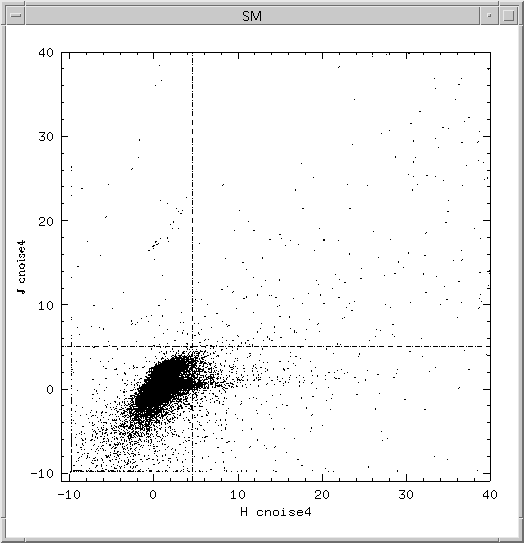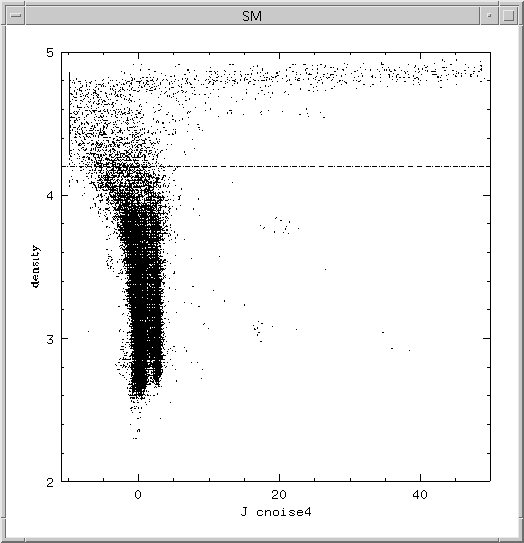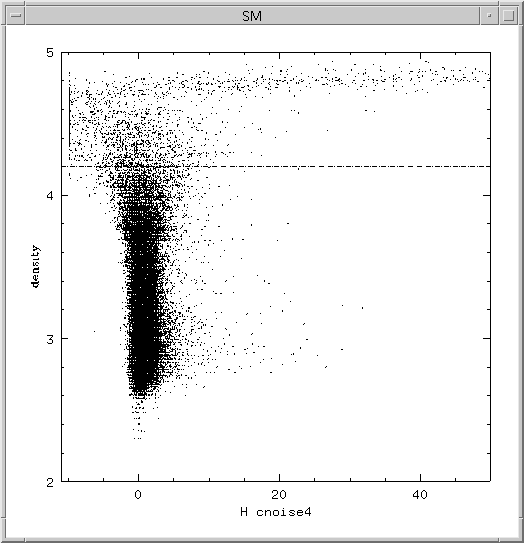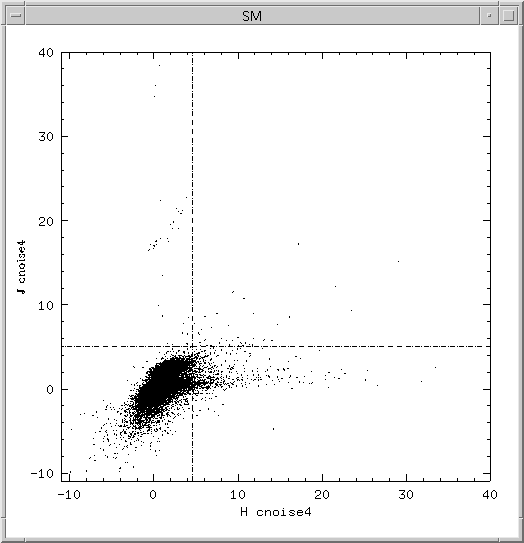
Following recent discussions it appears we will relax the Jcn4 < 5.0 requirement and inspect such cases by hand since they are so few in number.
First, consider a plot of Hcn4 plotted against Jcn4:

Fiducial lines are drawn at Hcn4 = 4.5, Jcn4 = 5.0. There is a significant population of points with high J & H cnoise scores. We believe that residual airglow structure should be dominant at H and not J, so this population must be attibutable to something else.
Next consider plots of Jcn4 vs. Kden and Hcn4 vs. Kden:


Clearly at high K source densities the reliability of the cnoise4 indicator becomes very poor. I've included a conservative fiducial cut at log density = 4.2. It's pretty clear that there is a significant correlation between J & H cnoise4 indicators above this line. In the Hcn4 vs. Kden plot (lower) it is also clear that there is a separate population of high noise scans at H with no J correspondants. I think these are our best airglow candidates.
Finally I present the first plot of Hcn4 vs. Jcn4, this time including only points with Kden < 4.2:

Now it looks like we've gotten rid of the bulk of those interlopers with both Jcn4 > 4.5 and Hcn4 > 5.0. The few remaining points in this regeme are most likely due to vertical diffraction spikes and similar phenomena which will show up at all bands.
Subject: analysis of upper left quadrant in cnoise4 plot
Date: Wed, 22 Dec 1999 19:28:28 -0800
From: Davy Kirkpatrick
Rae:
I've now looked at objects which fall in the upper left quadrant
of the bottom plot on Robert's web page --
http://spider.ipac.caltech.edu/staff/hurt/2mass/qa/cnoise4/
Specifically, I had Gene pull out of the SIT file all scans having
Hcn4<5.0, Jcn4>5.0, and Kden<4.2 (note, however, that Robert's plot
used Kden<4.5). In all there were only 51 scans matching these criteria.
As can be seen from the analysis appended below, scans which live
in this region encompass both low-quality garbage (clouds, J-band
quadrant jumps, stray light from the moon, etc.) and high-quality data
(that happen to contain very bright stars). The low-quality garbage
was already filtered out through other means during QA review.
My recommendation based on this analysis is that we should retain
points in this region because we'd otherwise be tossing a few babies
out with the bathwater.
I'm now working on the list of scans falling in the upper right
quadrant and hope to have that list ready on Monday.
---Davy
*************
Night Scan(s) Qo Notes
------- ------- -- -----
970918n 078 0 All of these scans were "badly non-photometric"
083 0 and there was also a report of many of these
099 0 scans having J-band quadrant jumps (but since these
135-136 0 were quality=0 already, I'm not sure which of these
had jumps and which didn't).
980106n 071 10 (unknown -- after painstakingly bringing up all of the
coadds on the visualizer, I can see no reason why the
Jcn4 counts are so high)
970723n 023-037 0 The pre-amp box was changed out on this night and
078-093 0 had wrong setting so all of the J-band photometry
was incorrect, forcing all of these to quality=0.
It was also noted that many of these suffered from
J-band quadrant jumps, too, but again the specific
scans affected were not spelled out.
980702n 012 0 Scan had "severe problem in coadds 150-173, looking
as if something bright (and very blue) flew through or
nearby the field".
980404n 011 0 Scan had severe J-band background variations due to
stray light from the moon. (This scan was only about
25 degrees away from the moon.)
970920n 099 10 (unknown -- but source density must be very close to
the Kden=4.2 threshold)
981008n 041 0 Severely affected by clouds.
990508n 103 10 There is a monster bright star in this scan --
g Herculis, M6 III, V=5.01.
990501n 027 0 Severely affected by clouds.
991020s 091 10 Stray light in coadds 139-245 from the very bright star
HD 39775, K0 III, V= 5.98.
990804s 087 9 (unknown -- source density must again be near the
Kden=4.2 limit)
981107s 099 10 There is a very bright star in this scan --
S Pictoris, M7e, V=9.12.
990430s 036 0 Heavily impacted by clouds.
980607s 024 0 Severely affected by clouds.
990417s 092 10 This scan has Antares, M1.5 Ib, V=1.09. It doesn't get
much brighter than this.
990530s 024 0 Impacted by clouds.
981028s 122 10 This scan contains R Doradus, M8 IIIe, V=5.73. Possibly
even worse than Antares.
Subject: analysis of upper right quadrant in cnoise4 plot
Date: Mon, 27 Dec 1999 16:05:18 -0800
From: Davy Kirkpatrick
Rae:
I've now looked at objects which fall in the upper right quadrant
of the bottom plot on Robert's web page --
http://spider.ipac.caltech.edu/staff/hurt/2mass/qa/cnoise4/
Specifically, I had Gene pull out of the SIT file all scans having
Hcn4>5.0, Jcn4>5.0, and Kden<4.2 (note, however, that Robert's plot
used Kden<4.5). In all there were only 48 scans matching these criteria.
As you suggested, I only inspected those scans having quality>4, and
that list is appended below. In every case, Jcn4 and Hcn4 seem to be
high either because of a monster bright star causing severe background
variations (as Robert had pointed out earlier) or because of a combination
of moderately high source density combined with moderate or bad airglow.
Of the 21 scans in the appended table, 13 do not contain monster
bright stars. It may be worth rescanning these since airglow does appear
to have been a factor in their receiving high cn4 values.
---Davy
**************
Night Scan(s) Qo Notes
------- ------- -- -----
990318n 131 10 This scan has the very bright star alpha Herculis,
M4 Ib-II, V=3.5.
980515n 063 10 This scan has Arcturus, K1.5 III, V=-0.04.
991020s 092 10 This scan has the very bright star HD 39775, K0 III,
V=5.98. Although this one may not seem to be a monster
based on its type and V magnitude, it was noted in the
QA review that there was a lot of stray light from this
one over coadds 139-245.
990720s 073 10 This scan has V2392 Ophiuchi, M4 III, V=6.2.
990807s 089 10 Despite the moderately high density of this scan
(Kdens = 3.75), I see no reason from the visualizer
coadds why the cnoise4 numbers should be high.
However, a combination of bad airglow plus high density
may be enough to cause high values in cases like this,
and this scan does show airglow variations even above
the stellar background for a couple of coadds.
990721s 075,085, 10 Again, there's no obvious reason from the QA review
089 why the cnoise4 counters are high, but these scans are
of moderately high density (3.74 < Kdens < 3.92). Some
bad airglow was also noted for these scans.
990723s 096 10 Again, just a high density field (Kdens = 4.04).
990724s 054-056, 10 Again, just high density fields (3.93 < Kdens < 4.00).
064-066, However, these scans (and ones around them) contain some
096 particularly nasty episodes of airglow variability.
980602s 067 10 This scan has W Hydrae, M8e, V=7.0 (var). Noted in the
QA review as "extremely bright" and causing background
jumps as far as three coadds east/west of the star
itself.
980714s 036 10 This scan contains the southern diffraction spike from
Antares. It is noted that this vertical spike is seen
more than 6 degrees away from Antares itself.
990617s 027 9 Most likely, this scan is triggered because of high
density (Kdens = 4.19) and bad airglow (as noted in
review).
991026s 113 10 Stray light over coadds 9-127 was noted in this scan
during QA review. Most likely the culprit is Canopus
even though Canopus is not in the scan itself.
981024s 123 7 This scan contains vertical diffraction spikes from
the monster bright star R Doradus.